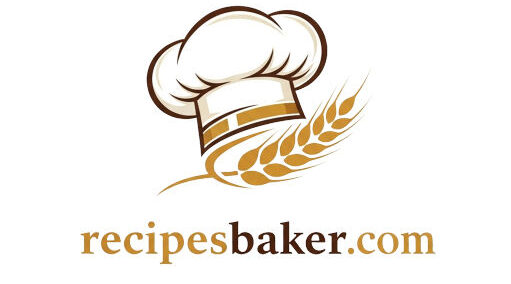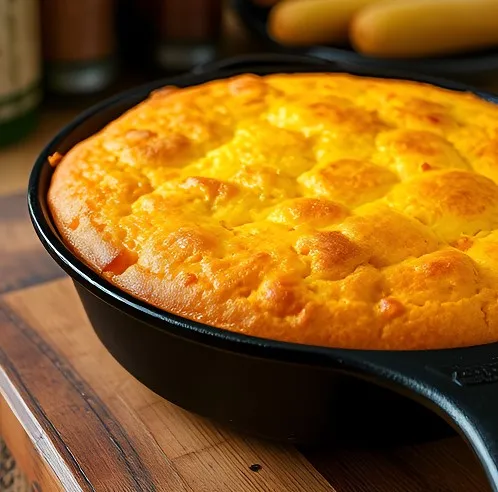When it comes to Southern cuisine, few dishes embody comfort and tradition like cornbread. This isn’t your dry, crumbly, Yankee cornbread; we’re talking about the real deal: moist, flavorful, and totally unforgettable. If you’ve ever searched for the perfect Southern cornbread recipe, your search ends here. Let’s dive into what makes Southern cornbread unique, explore essential ingredients, walk through a step-by-step baking process, and uncover variations to suit every palate.
What Makes Southern Cornbread Unique?
Defining Authentic Southern Cornbread
Southern cornbread stands apart from its northern counterpart primarily due to its savory profile. Unlike the sweet, cake-like cornbread found in the North, Southern cornbread is designed to complement hearty dishes like greens and barbecue. The use of a cast iron skillet is a hallmark of Southern baking, providing a crispy, golden crust that adds texture and depth to every bite. This method ensures a sturdy, corn-forward side that holds up well alongside generous servings of Southern staples.
Key Differences: Northern vs. Southern Cornbread
Northern cornbread tends to be sweeter and more cake-like, often incorporating significant amounts of sugar and flour. In contrast, Southern cornbread emphasizes cornmeal as the star ingredient, using less flour and little to no sugar. This results in a denser, more rustic bread that delivers a robust corn flavor. The texture of Southern cornbread is intentionally crumbly yet hearty, making it an ideal accompaniment to rich, savory dishes.
The Importance of Skillets in Southern Cornbread
A cast iron skillet isn’t just a cooking vessel; it’s an essential tool for achieving the perfect Southern cornbread. The skillet’s ability to distribute heat evenly and retain it ensures a uniformly crisp crust. This method imparts a characteristic golden-brown edge that’s slightly crunchy, providing a delightful contrast to the moist interior. Beyond functionality, the skillet adds a touch of Southern charm to the baking process, often becoming a cherished family heirloom passed down through generations.
Essential Ingredients for a Classic Southern Cornbread Recipe
The Role of Cornmeal: Stone-Ground vs. Other Varieties
Cornmeal is the backbone of any cornbread recipe, and for Southern cornbread, medium-grind, stone-ground cornmeal is preferred. Stone-ground cornmeal offers a more robust flavor and a slightly coarser texture, enhancing the rustic quality of the bread. Finely ground cornmeal can result in a smoother, almost powdery texture, which isn’t ideal for the hearty structure Southern cornbread demands. Opting for stone-ground ensures a rich, authentic taste that stands out on the plate.
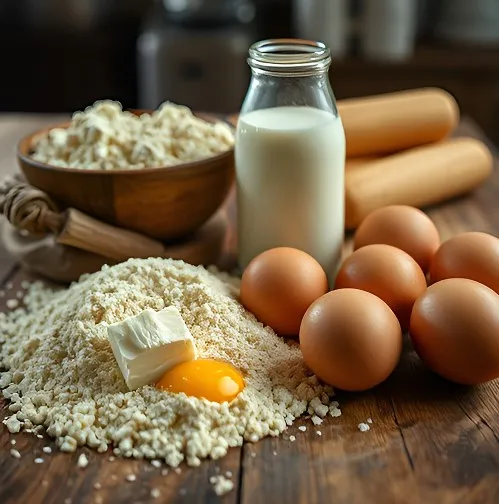
Understanding Buttermilk in Southern Cornbread
Buttermilk plays a crucial role in Southern cornbread, contributing to its moist texture and tangy flavor. It also activates leavening agents, helping the bread rise beautifully. The acidity in buttermilk tenderizes the batter, resulting in a softer crumb. While a substitute can be made using regular milk with a splash of lemon juice or vinegar, genuine buttermilk provides the depth of flavor and tenderness that elevates the cornbread to its traditional excellence.
Fats: Lard, Shortening, or Butter?
The choice of fat significantly impacts the flavor and texture of cornbread. Traditionally, lard is used for its rich, old-fashioned taste. However, modern variations often employ shortening or butter. Shortening yields a tender and moist bread, while butter adds a delightful flavor but can make the bread denser. A combination of butter and shortening offers the best of both worlds, ensuring a flavorful and moist cornbread with the perfect crumb.
The Function of Eggs and Leavening
Eggs are essential in binding the ingredients together and adding richness to the cornbread. Leavening agents like baking powder and baking soda are indispensable for achieving the desired rise. Accurate measurements of these ingredients are critical; using fresh baking powder and baking soda ensures optimal leavening action. These components work in harmony with the wet and dry ingredients to create a light yet sturdy texture, hallmark traits of exceptional Southern cornbread.
Step-by-Step: Baking the Perfect Southern Cornbread Recipe
Preparing the Cast Iron Skillet
Begin by preheating your oven to 425°F (220°C) with a 10-inch cast iron skillet inside. Preheating the skillet ensures a hot surface that will create the coveted crispy crust. Once the oven reaches the desired temperature, carefully remove the skillet using oven mitts. Add your chosen fat—be it melted butter, shortening, or a mix—to the hot skillet, ensuring it coats the entire bottom and sides evenly. This step is crucial for preventing sticking and achieving that perfect golden-brown crust.
Mixing the Dry Ingredients
In a large bowl, whisk together the cornmeal, all-purpose flour (if using), baking powder, baking soda, and salt. Thoroughly combining these dry ingredients ensures an even distribution of flavor and leavening agents, preventing lumps and promoting a consistent texture in the final cornbread. Taking the time to mix these components well sets the foundation for a perfectly balanced batter.
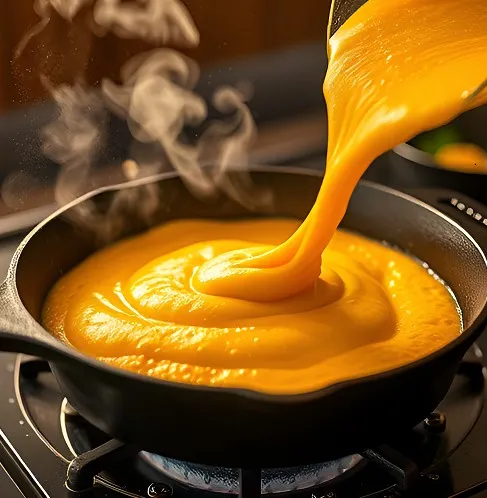
Combining Wet and Dry Ingredients Cornbread Recipe
In a separate bowl, whisk together the buttermilk, melted butter or shortening, and egg. Pour the wet mixture into the dry ingredients and gently stir until just combined. It’s important to avoid overmixing; a few lumps are perfectly acceptable and contribute to the cornbread’s hearty texture. Overmixing can lead to toughness, undermining the tender crumb that defines excellent Southern cornbread.
The Importance of a Hot Skillet
Once your batter is ready, carefully pour it into the preheated cast iron skillet. You should hear a satisfying sizzle as the batter meets the hot surface—this is the start of creating that beautiful crust. Spread the batter evenly to ensure uniform baking. The hot skillet is instrumental in developing the signature crispy exterior, making this step non-negotiable for authentic results.
Baking Time and Temperature for Golden Perfection
Place the skillet back into the preheated oven and bake for approximately 20-25 minutes. The cornbread is done when it achieves a deep golden brown color and a toothpick inserted into the center emerges clean. Monitor the baking process closely, as oven temperatures can vary. The top should be evenly browned, indicating that the cornbread is perfectly baked and ready to be enjoyed.
Cooling and Serving Suggestions
After baking, allow the cornbread to cool in the skillet for a few minutes before slicing. This brief cooling period helps set the structure, making it easier to cut and serve. Serve the cornbread warm, either straight from the skillet or transferred to a serving plate. It pairs beautifully with melted butter, honey, jam, or alongside savory dishes like chili, collard greens, or barbecue. The versatility of Southern cornbread makes it a standout addition to any meal.
Variations on a Traditional Southern Cornbread Recipe
Adding Sweetness: Sugar or Honey?
While traditional Southern cornbread leans savory, adding a touch of sweetness can cater to different preferences. Incorporating a tablespoon or two of sugar or honey into the batter introduces a subtle sweetness without overpowering the cornbread’s inherent corn flavor. Honey adds a floral nuance, whereas sugar enhances the overall sweetness. This slight modification allows for personalization while maintaining the bread’s traditional character.
Cheese Cornbread Variations for Extra Flavor
Introducing cheese into cornbread is a popular and delicious variation. Adding a cup of shredded cheddar, Monterey Jack, or even crumbled feta enriches the bread with savory depth and additional moisture. Cheese that melts well, such as sharp cheddar, provides a delightful gooey texture and a flavorful punch. This variation not only enhances taste but also adds visual appeal, making the cornbread even more enticing.
Incorporating Jalapeños or Other Peppers
For those who enjoy a spicy kick, adding jalapeños or other peppers can elevate the cornbread experience. Finely chopped jalapeños, with seeds removed for less heat, blend seamlessly into the batter, introducing a pleasant spiciness. Alternatives like serranos or poblanos can also be used to adjust the heat level to your liking. This addition brings a vibrant, zesty twist to the traditional recipe, adding both flavor and character.
Herbs and Spices to Elevate Your Cornbread
Experimenting with herbs and spices can add complexity and elevate the flavor profile of your cornbread. Incorporating thyme, rosemary, or smoked paprika introduces aromatic notes that complement the cornmeal base. Starting with a teaspoon or two allows for controlled enhancement, ensuring that the added flavors harmonize without overwhelming the cornbread. Fresh or dried herbs can be used based on availability and preference, offering endless possibilities for customization.
Vegan Southern Cornbread Recipe Adjustments
Adapting the cornbread recipe for a vegan diet is straightforward with a few ingredient substitutions. Replace buttermilk with non-dairy milk, such as almond or soy, combined with a splash of lemon juice or apple cider vinegar to mimic acidity. Use a vegan butter substitute in place of traditional butter or shortening, and substitute the egg with a flax egg (1 tablespoon ground flaxseed mixed with 3 tablespoons water). These adjustments preserve the bread’s moistness and flavor, ensuring a delectable plant-based Southern cornbread.
Troubleshooting Common Southern Cornbread Issues
Dry or Crumbly Cornbread? Causes and Fixes
Dry, crumbly cornbread often results from excessive cornmeal, insufficient liquid, or overbaking. To prevent dryness, ensure accurate measurement of ingredients and monitor baking time closely. Incorporating a bit more buttermilk can add necessary moisture, while reducing cornmeal slightly can improve texture. Striking the right balance between ingredients and baking duration is key to achieving a moist, tender cornbread.
Dense or Heavy Cornbread: How to Avoid It
A dense, heavy cornbread may stem from overmixing the batter or using stale leavening agents. To maintain a light texture, mix the batter just until combined, allowing a few lumps to remain. Additionally, verify the freshness of baking powder and baking soda to ensure effective leavening. Gentle handling of the batter preserves the cornbread’s structure, preventing unwanted heaviness and promoting a more airy crumb.
Uneven Cooking: Solutions for Consistent Results
Uneven cooking can occur due to inconsistent oven temperatures or improperly preheated skillets. Using an oven thermometer ensures accurate baking temperatures, while allowing ample time for the skillet to heat thoroughly prevents uneven crust formation. Rotating the skillet halfway through baking can also mitigate hot spots in the oven, promoting uniform cooking and consistent results across the entire cornbread.
Burnt Edges and Bottoms: Prevention Tips
Burnt edges and bottoms usually result from an excessively hot skillet or prolonged baking times. To avoid burning, ensure the skillet is adequately coated with fat and not overheated before adding the batter. If the cornbread begins to brown too quickly, loosely covering it with aluminum foil can protect the edges while allowing the center to finish baking. Adjusting oven racks and monitoring the baking process closely also help prevent unwanted burning.
Serving and Storing Your Delicious Southern Cornbread
Best Ways to Serve Warm Southern Cornbread
A slice of warm Southern cornbread is a quintessential comfort food experience. Serve it plain, spread with melting butter, drizzled with honey, or topped with jam for a simple yet satisfying treat. For savory pairings, cornbread complements dishes like chili, barbecue, and collard greens exceptionally well. Its versatility makes it a perfect addition to both casual meals and festive gatherings, standing out as a beloved staple in Southern cuisine.
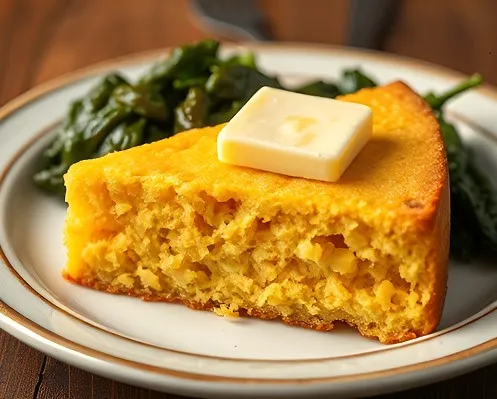
Ideas for Leftover Southern Cornbread
Leftover cornbread can be repurposed in numerous creative ways. Crumble it to create a flavorful stuffing base, incorporate it into bread pudding for a sweet twist, or transform it into cornbread croutons for salads. Toasted slices with a touch of butter make for an easy breakfast or snack. These versatile applications ensure that no slice goes to waste, allowing you to enjoy cornbread in various delightful forms.
Proper Storage Techniques
To maintain the freshness of your cornbread, store it appropriately. Allow the bread to cool completely before wrapping it tightly in plastic wrap or placing it in an airtight container. At room temperature, cornbread stays fresh for 2-3 days. For longer storage, refrigerate it for up to a week or freeze it for up to three months. When freezing, ensure the cornbread is well-wrapped in freezer-safe materials to prevent freezer burn. Proper storage preserves the cornbread’s moistness and flavor, ensuring it’s ready to enjoy whenever you crave it.
A Detailed Southern Cornbread Recipe with Tips & Tricks
A Printable, Easy-to-Follow Southern Cornbread Recipe
Here’s a tried-and-true Southern cornbread recipe that’s easy to follow and guaranteed to impress:
Ingredients:
- 1 1/2 cups medium-grind cornmeal (preferably stone-ground)
- 1/2 cup all-purpose flour (optional, for a less crumbly texture)
- 1 teaspoon baking powder
- 1/2 teaspoon baking soda
- 1 teaspoon salt
- 1 1/2 cups buttermilk
- 1/4 cup melted butter or shortening (or a mix)
- 1 large egg
Instructions:
- Preheat the Oven and Skillet: Preheat your oven to 425°F (220°C). Place a 10-inch cast iron skillet in the oven to heat.
- Mix Dry Ingredients: In a large bowl, whisk together the cornmeal, all-purpose flour (if using), baking powder, baking soda, and salt until well combined.
- Combine Wet Ingredients: In a separate bowl, whisk together the buttermilk, melted butter or shortening, and egg.
- Combine Wet and Dry Mixtures: Pour the wet ingredients into the dry ingredients and gently stir until just combined. Do not overmix.
- Prepare the Skillet: Carefully remove the hot skillet from the oven. Pour in the melted fat, ensuring the bottom and sides are evenly coated.
- Pour the Batter: Quickly pour the batter into the hot skillet, spreading it evenly to cover the entire surface.
- Bake: Return the skillet to the oven and bake for 20-25 minutes, or until the cornbread is golden brown and a toothpick inserted into the center comes out clean.
- Cool and Serve: Allow the cornbread to cool in the skillet for a few minutes before slicing and serving.
Tips for Cornbread Success:
- Hot Skillet is Key: Ensure your cast iron skillet is thoroughly heated before adding the batter to achieve a crispy crust.
- Don’t Overmix: Mix the batter just until ingredients are combined to maintain a tender crumb.
- Fresh Leavening Agents: Use fresh baking powder and baking soda to ensure your cornbread rises properly.
- Experiment with Add-ins: Enhance flavor by adding cheese, jalapeños, or herbs according to your preference.
- Use Buttermilk: Authentic buttermilk imparts the best flavor and texture, but a substitute can be used if necessary.
- Enjoy It!: Embrace the process and savor the results. Imperfections are part of the homemade charm that makes Southern cornbread so beloved.
Now go on, and bake your amazing Southern cornbread! You’ve got this!
Frequently Asked Questions
How long is homemade cornbread good for?
Homemade cornbread stays fresh at room temperature for 2-3 days when properly stored in an airtight container. For longer storage, it can be refrigerated for up to a week or frozen for up to three months. Freezing preserves the moisture and flavor, allowing you to enjoy cornbread at your convenience.
What is cornbread famous for?
Cornbread is renowned for its role in Southern cuisine, where it serves as a versatile side dish that complements a variety of hearty meals. Its unique combination of a crispy crust and moist interior makes it a beloved staple, especially alongside dishes like chili, barbecue, and collard greens.
What makes cornbread crack on top?
A cracked top on cornbread is typically a sign of a well-baked loaf. The intense heat from the preheated cast iron skillet causes the batter to rise quickly, forming a crust with characteristic cracks as it bakes. This cracking is a desirable feature, indicating a perfect balance between a crunchy exterior and a tender interior.
How should cornbread look when done?
When properly baked, cornbread should have a deep golden-brown color on the exterior with a slightly crispy crust. The interior should be moist and tender, and a toothpick inserted into the center should come out clean. The bread should hold its shape well, making it easy to slice and serve.
Conclusion
Southern cornbread is more than just a side dish; it’s a culinary tradition that brings warmth and comfort to the table. By understanding the unique characteristics of Southern cornbread, selecting the right ingredients, and following a meticulous baking process, you can create a cornbread that’s moist, flavorful, and utterly unforgettable. Whether you stick to the classic recipe or explore delightful variations, this cornbread is sure to become a cherished favorite in your kitchen.
